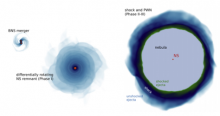
Abstract
Growing evidence connects the progenitor systems of the short-hard subclass of gamma-ray bursts (GRBs) to the merger of compact object binaries composed of two neutron stars (NSs) or of an NS and a black hole (BH). The recent observation of the binary NS (BNS) merger event GW170817 associated with GRB 170817A brought a great deal of additional information and provided further support to the above connection, even though the identification of this burst as a canonical short GRB (SGRB) remains uncertain. Decades of observational constraints and theoretical models consolidated the idea of a jet origin for the GRB prompt emission, which can also explain the multiwavelength afterglow radiation observed in most of the events. However, the mechanisms through which a BNS or NS–BH merger remnant would power a collimated outflow are much less constrained. Understanding the properties of the remnant systems and whether they can provide the right conditions for jet production has been a main driver of the great effort devoted to study BNS and NS–BH mergers, and still represents a real challenge from both the physical and the computational points of view. One fundamental open question concerns the nature of the central engine itself. While the leading candidate system is a BH surrounded by a massive accretion disk, the recent observation of plateau-shaped X-ray afterglows in some SGRBs would suggest a longer-lived engine, i.e. a metastable (or even stable) massive NS, which would also exclude NS–BH progenitors. Here we elaborate on this key aspect, considering three different scenarios to explain the SGRB phenomenology based on different hypotheses on the nature of the merger remnant. Then, we discuss the basic properties of GRB 170817A and how this event would fit within the different frameworks of the above scenarios, under the assumption that it was or was not a canonical SGRB.